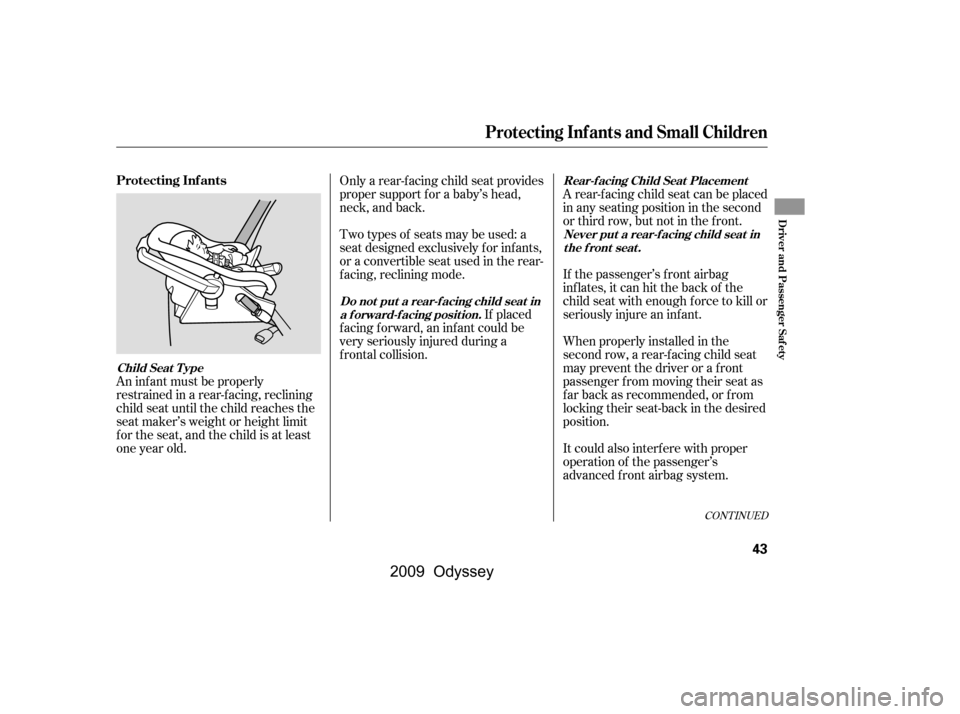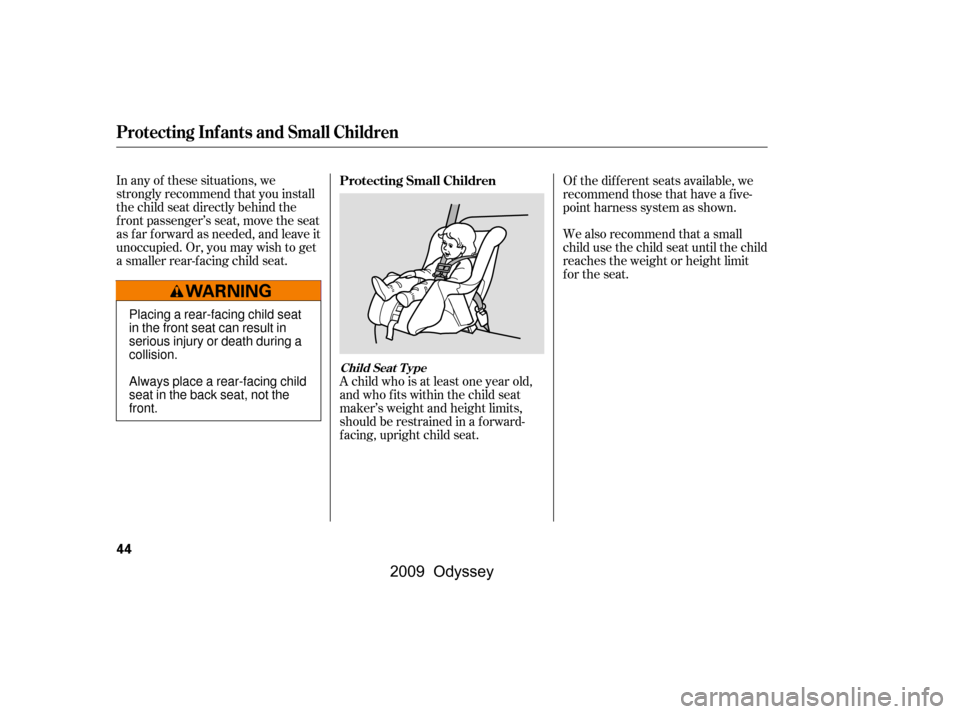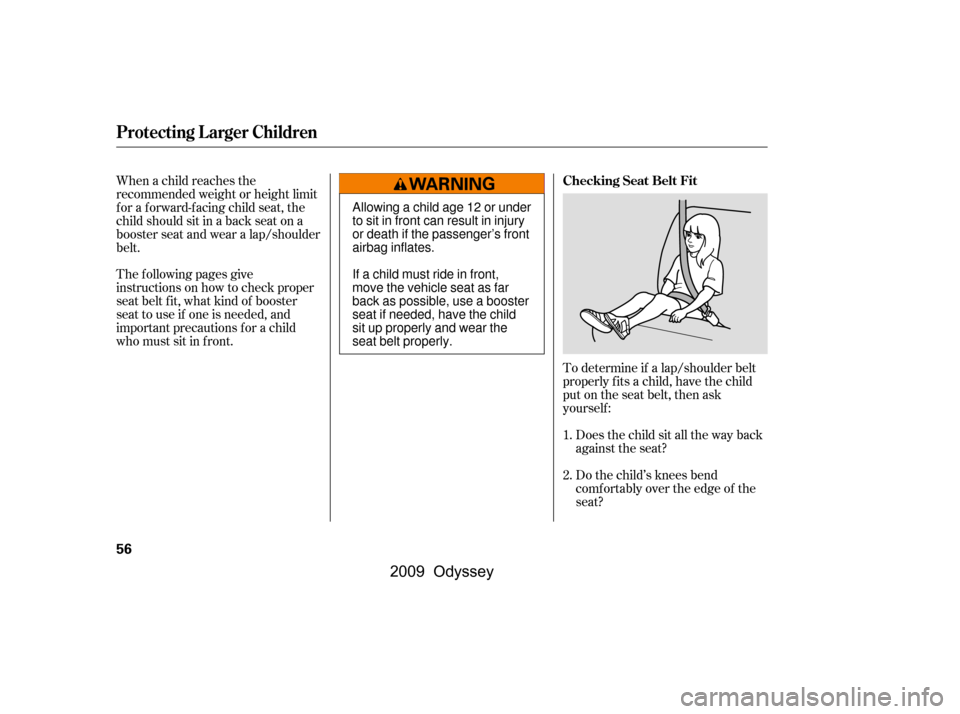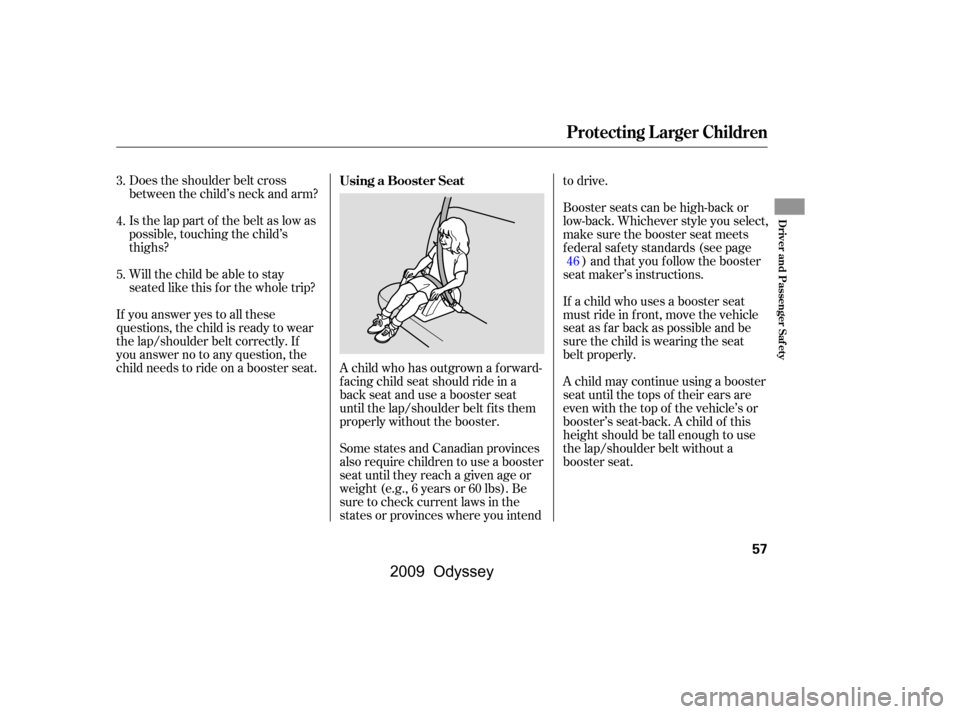Page 46 of 532

An inf ant must be properly
restrained in a rear-f acing, reclining
child seat until the child reaches the
seat maker’s weight or height limit
f or the seat, and the child is at least
one year old.If the passenger’s front airbag
inflates, it can hit the back of the
child seat with enough f orce to kill or
seriously injure an inf ant.
When properly installed in the
second row, a rear-f acing child seat
maypreventthedriverorafront
passenger f rom moving their seat as
f ar back as recommended, or f rom
locking their seat-back in the desired
position.
If placed
f acing f orward, an inf ant could be
very seriously injured during a
f rontal collision.
Two types of seats may be used: a
seat designed exclusively f or inf ants,
or a convertible seat used in the rear-
f acing, reclining mode.
Only a rear-f acing child seat provides
proper support f or a baby’s head,
neck, and back. A rear-f acing child seat can be placed
in any seating position in the second
or third row, but not in the f ront.
It could also interf ere with proper
operation of the passenger’s
advanced front airbag system.
CONT INUED
Protecting Inf ants
Child Seat T ype Do not put a rear-f acing child seat in
a f orward-f acing position. Rear-f acing Child Seat Placement
Never put a rear-f acing child seat inthe front seat.
Protecting Inf ants and Small Children
Driver and Passenger Saf ety
43
�\f���—�\f���—���
�y�
�
��
����
���y���
�(���������\f�y�\f�\f�����y
2009 Odyssey
Page 47 of 532

In any of these situations, we
strongly recommend that you install
the child seat directly behind the
f ront passenger’s seat, move the seat
as far forward as needed, and leave it
unoccupied. Or, you may wish to get
a smaller rear-f acing child seat.
A child who is at least one year old,
and who fits within the child seat
maker’s weight and height limits,
should be restrained in a f orward-
f acing, upright child seat.
Of the different seats available, we
recommend those that have a f ive-
point harness system as shown.
We also recommend that a small
child use the child seat until the child
reaches the weight or height limit
for the seat.
Protecting Small Children
Child Seat T ype
Protecting Inf ants and Small Children
44
Placing a rear-facing child seat
in the front seat can result in
serious injury or death during a
collision.
Always place a rear-facing child
seat in the back seat, not the
front.
�����—�����—���
�y�
�
��
��������y���
�(�����������y���������y
2009 Odyssey
Page 55 of 532

To deactivate the lockable retractor
and remove a child seat, unlatch the
buckle, unroute the seat belt, and let
the belt fully retract.Push and pull the child seat
f orward and f rom side-to-side to
verify that it is secure enough to
stay upright during normal driving
maneuvers. If the child seat is not
secure, unlatch the belt, allow it to
retract f ully, then repeat these
steps.
Af ter conf irming that the belt is
locked, grab the shoulder part of
the belt near the buckle, and pull
up to remove any slack from the
lap part of the belt. Remember, if
the lap part of the belt is not tight,
the child seat will not be secure.
To activate the lockable retractor,
slowly pull the shoulder part of the
belt all the way out until it stops,
then let the belt f eed back into the
retractor.
Af ter the belt has retracted, tug on
it. If the belt is locked, you will not
be able to pull it out. If you can pull
thebeltout,itisnotlocked,and
you will need to repeat these steps.
To remove slack, it may help to
putweightonthechildseat,or
push on the back of the seat while
pulling up on the belt.5.
4.
2.
3.
Installing a Child Seat
52
�\f���—�\f���—���
�y�
�
����\f������y���
�(���������\f�y�\f�\f�����y
2009 Odyssey
Page 59 of 532

To determine if a lap/shoulder belt
properly f its a child, have the child
put on the seat belt, then ask
yourself :
Does the child sit all the way back
against the seat?
Do the child’s knees bend
comf ortably over the edge of the
seat?
When a child reaches the
recommended weight or height limit
for a forward-facing child seat, the
child should sit in a back seat on a
booster seat and wear a lap/shoulder
belt.
The f ollowing pages give
instructions on how to check proper
seat belt f it, what kind of booster
seat to use if one is needed, and
important precautions f or a child
who must sit in f ront.
1.
2.
Checking Seat Belt Fit
Protecting L arger Children
56
Allowing a child age 12 or under
to sit in front can result in injury
or death if the passenger’s front
airbag inflates.
If a child must ride in front,
move the vehicle seat as far
back as possible, use a booster
seat if needed, have the child
sit up properly and wear the
seat belt properly.
�����—�����—���
�y�
�
�����������y���
�(�����������y�������
�y
2009 Odyssey
Page 60 of 532

A child who has outgrown a forward-
f acing child seat should ride in a
back seat and use a booster seat
until the lap/shoulder belt f its them
properly without the booster.
Does the shoulder belt cross
between the child’s neck and arm?
Is the lap part of the belt as low as
possible, touching the child’s
thighs?
Will the child be able to stay
seated like this f or the whole trip?
If you answer yes to all these
questions, the child is ready to wear
the lap/shoulder belt correctly. If
you answer no to any question, the
child needs to ride on a booster seat.
Some states and Canadian provinces
also require children to use a booster
seat until they reach a given age or
weight (e.g., 6 years or 60 lbs). Be
sure to check current laws in the
states or provinces where you intendto drive.
Booster seats can be high-back or
low-back. Whichever style you select,
make sure the booster seat meets
f ederal saf ety standards (see page
) and that you f ollow the booster
seat maker’s instructions.
If a child who uses a booster seat
must ride in f ront, move the vehicle
seat as far back as possible and be
sure the child is wearing the seat
belt properly.
A child may continue using a booster
seat until the tops of their ears are
even with the top of the vehicle’s or
booster’s seat-back. A child of this
height should be tall enough to use
the lap/shoulder belt without a
booster seat.
3.
4.
5.
46
Using a Booster Seat
Protecting L arger Children
Driver and Passenger Saf ety
57
�\f���—�\f���—���
�y�
�
����
��\f���y���
�(���������\f�y�\f�\f�����y
2009 Odyssey
Page 70 of 532

The instrument panel has many
indicators to give you important
inf ormation about your vehicle. If this indicator comes on when theengine is running, the battery is not
being charged. For more inf ormation,
see page .
For more inf ormation, see page . This indicator comes on f or several
seconds when you turn the ignition
switch to the ON (II) position. If it
comes on at any other time, it
indicates a potential problem with
your f ront airbags. This indicator will
also alert you to a potential problem
with your side airbags, passenger’s
side airbag automatic cutoff system,
side curtain airbags, automatic seat
belt tensioners, driver’s seat position
sensor, or the f ront passenger’s
weight sensors. For more
inf ormation, see page .
You will also see a ‘‘CHECK
EMISSION SYSTEM’’ message on
the multi-information display (see
page ).
You will also see a ‘‘CHECK
CHARGING SYSTEM’’ message on
the multi-information display (see
page ).
The engine can be severely damaged
if this indicator f lashes or stays on
when the engine is running. For
more information, see page .
You will also see a ‘‘CHECK
ENGINE OIL LEVEL’’ message on
the multi-information display (see
page ).You will also see a ‘‘CHECK
AIRBAG SYSTEM’’ message on the
multi-inf ormation display (see page
). 34
88
88
88 88
480
479
479
On Touring models On Touring models
On Touring models On Touring models
Malf unction Indicator
LampCharging System
Indicator
Supplemental Restraint
System (SRS) Indicator
L ow Oil Pressure
Indicator
Instrument Panel Indicators
Inst rument s and Cont rols
67
�����—�����—���
�y�
�
�����������y���
�(�����������y���������y
2009 Odyssey
Page 101 of 532
If there is a problem with the
parking sensor system, the multi-
inf ormation display shows a
‘‘CHECK PARKING SENSOR
SYSTEM’’ message. See pagef or more inf ormation.
If there is a problem in the anti-lock
brake system (ABS), you will see
‘‘CHECKABSSYSTEM’’onthe
multi-inf ormation display. If you see
this message, have your vehicle
checked by a dealer (see page ). If there is a problem with your f ront
airbags, side airbags, passenger’s
side airbag automatic cutoff system,
automatic seat belt tensioners, side
curtain airbags, driver’s seat position
sensor, or the f ront passenger’s
weight sensors, you will see
‘‘CHECK AIRBAG SYSTEM’’ on the
multi-inf ormation display. Take your
vehicle to a dealer as soon as
possible(seepage ).
34
392
363
Multi-Inf ormation Display
Check Parking Sensor Syst em
Check A irbag Syst em
Check A BS Syst em
98
�\f���—�\f���—���
�y�
�
���������
�y���
�(���������\f�y�\f�
�\f���y
2009 Odyssey
Page 203 of 532

There is a large storage area under
the floor between the front seats and
the second row bucket seats.
To place or remove large items f rom
the storage area, pull off the carpet
near the second row seat, and pull
thehandletoopenthelargelid.You can store items in the f loor
storageareaupto22lbs(10kg).Do
not exceed this weight limit, or you
may damage the floor storage area.
Theinsideof thestorageareacan
get very hot. Do not store any items
that should be kept cool, or items
that can be easily damaged, warped,
or def ormed by heat.
Dust, sand, etc., can accumulate in
the f loor storage area. If you spill
liquid on the f loor around the f loor
storage area, it can get inside the
storage area, and the moisture can
be trapped inside. Always keep the
inside of the storage area dry and
clean.
To prevent items f rom being thrown
about the vehicle and possibly
hurting someone in an accident or
sudden stop, be sure the storage
area lids are securely closed bef ore
driving away.
You can adjust the length of the
hook strap. Pull down the upper
edge of the stopper, and slide it up or
down.
To keep the lid open, attach the hook
to the grab rail on the back of the
f ront seat-back.If equipped
In-Floor Storage A rea
Interior Convenience Items
200
HANDLE HOOK
LID
�\f���—�\f���—���
�y�
�
����
��\f�\f�y���
�(���������\f�y�\f���\f���y
2009 Odyssey